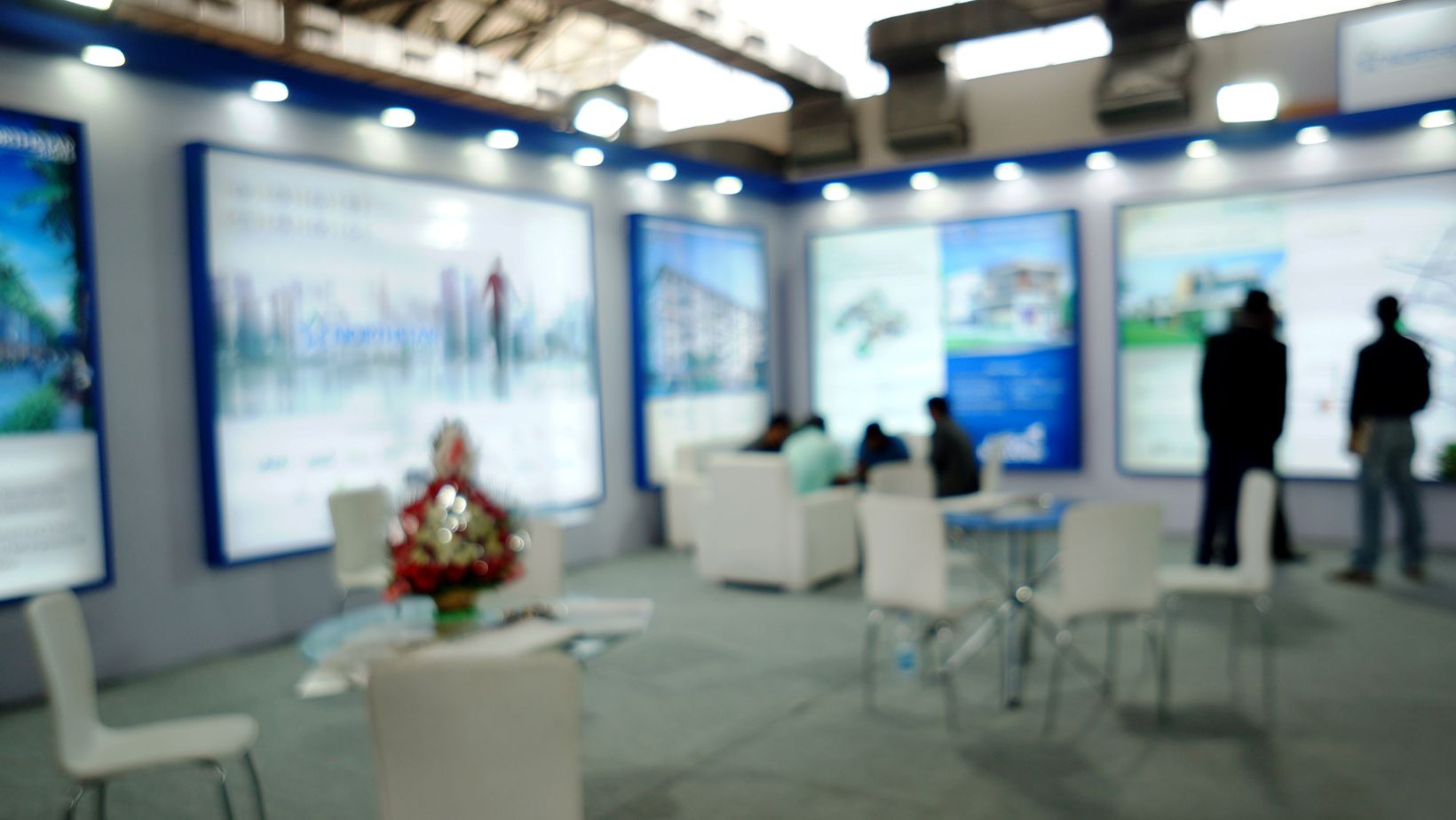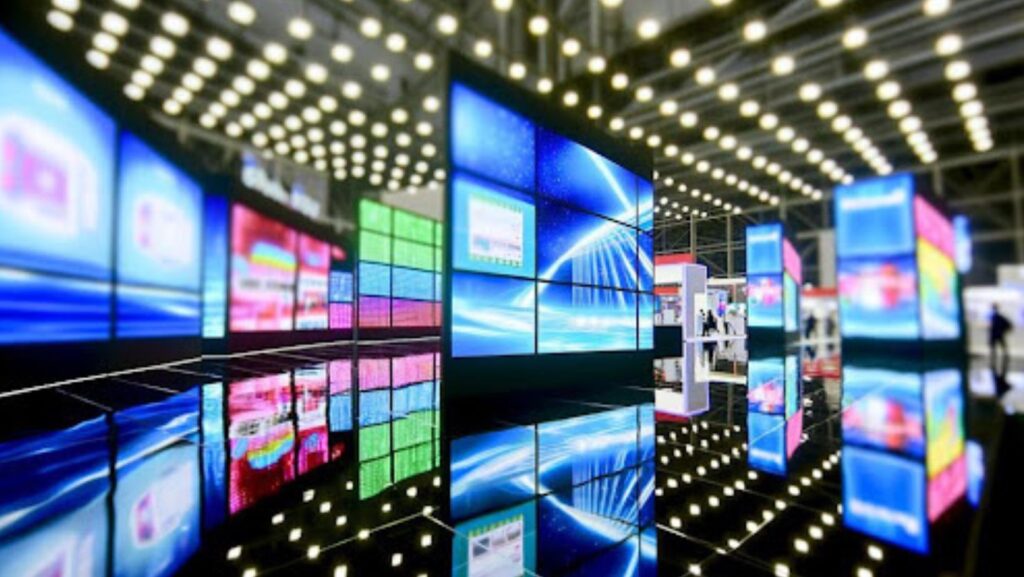Imagine you’re the modern-day P.T. Barnum, aiming to captivate your audience at a trade show. Trade Show LED displays offer you unparalleled brightness and clarity, ensuring your booth stands out. With their high luminosity and energy efficiency, these displays provide a visually compelling way to showcase your products and services. But how do you choose the right type—indoor, outdoor, or flexible? By focusing on key features like pixel pitch, brightness levels, and refresh rates, you can create an impactful display. So, what steps should you take to design a captivating presence?
Benefits of LED Displays
Tradeshow LED display offer unparalleled brightness and clarity, making them a crucial asset for capturing attention at trade shows. You’ll find that their high luminosity ensures your booth stands out, even in well-lit environments. This attribute is vital for enhancing brand visibility amidst the crowded and competitive atmosphere of trade shows.
Another significant advantage of LED displays is their energy efficiency. Unlike traditional lighting solutions, LEDs consume less power while delivering superior brightness. This efficiency not only reduces operational costs but also aligns with sustainable practices, something increasingly valued in today’s corporate landscape. By utilizing LED technology, you can achieve a high-impact presence without the burden of exorbitant energy expenses.

Moreover, LED displays provide exceptional resolution and color accuracy, which are essential for presenting your brand’s visuals in the best light possible. High-definition content becomes more engaging, drawing in potential clients and leaving a lasting impression.
The dynamic capabilities of LED screens allow for real-time updates and interactive features, further increasing audience engagement.
Types of LED Displays
Understanding the various types of LED displays is crucial for selecting the right solution tailored to your trade show needs. Primarily, you’ll encounter three main categories: indoor, outdoor, and flexible LED displays.
Indoor LED displays are designed for environments with controlled lighting, making them ideal for retail displays where high resolution and close viewing distances are paramount. These displays ensure crisp visuals and vibrant colors, enhancing your booth’s appeal.
Outdoor signage LED displays are engineered to withstand harsh environmental conditions. They feature weather-resistant casings and high brightness levels to combat direct sunlight, ensuring your message remains visible. These are perfect for large-scale promotions on the exterior of trade show venues, attracting attendees from a distance.
Flexible LED displays offer unparalleled versatility. Their lightweight, bendable panels can conform to various shapes and surfaces, providing innovative ways to captivate your audience. These are particularly beneficial for creating immersive experiences or unique booth designs that stand out.
Each type serves distinct purposes, and understanding their specific applications can significantly impact your trade show success. By leveraging the right LED display, you can effectively draw attention, communicate your brand message, and enhance overall visitor engagement.
Key Features to Consider
When selecting an LED display for your trade show booth, consider critical features such as pixel pitch, brightness, refresh rate, and durability to ensure optimal performance and impact.
Pixel pitch, the distance between the center of two adjacent pixels, directly influences resolution quality. A smaller pixel pitch means higher resolution and sharper images, crucial for close-up viewing common at trade shows.
Brightness levels are another vital factor. You’ll need a display that can handle the ambient light conditions of the exhibition hall. Look for LED displays with high nits (a unit of luminance) to maintain clarity and visibility even under harsh lighting. Typically, brightness levels around 1,000-1,500 nits are sufficient for indoor trade shows.
The refresh rate, measured in Hertz (Hz), affects the smoothness of motion in videos and animations. A higher refresh rate, ideally above 120Hz, ensures fluid transitions and reduces flickering, enhancing viewer experience.
Lastly, durability is non-negotiable. Your LED display should withstand the rigors of repeated setups and take-downs. Opt for displays with robust construction and reliable components to minimize downtime and maintenance.
Investing in these key features will elevate your trade show presence significantly.
Designing Your LED Display
Incorporating these critical features, you’ll want to design an LED display that not only captures attention but also conveys your brand’s message effectively. Start by utilizing custom graphics to create a visually compelling narrative. High-resolution imagery and dynamic animations can significantly enhance the visual appeal, drawing attendees’ eyes to your booth. Ensure your graphics are aligned with your brand identity, using consistent color schemes, logos, and taglines.

Next, focus on content management. Effective content management systems (CMS) allow you to schedule, update, and modify display content seamlessly. Opt for a CMS that supports various media formats, including video, slideshows, and real-time data feeds. This flexibility ensures your content remains fresh and engaging throughout the event.
Additionally, consider the display’s pixel pitch, which determines the clarity and sharpness of the visuals. For trade shows, a pixel pitch between 2mm and 3mm is recommended for close viewing distances.
Integrating Interactive Elements
Enhance attendee engagement by integrating interactive elements such as touchscreens, motion sensors, and augmented reality applications into your LED display. Incorporating touch screens allows participants to navigate through content at their own pace, providing a personalized experience. You can display product catalogs, promotional videos, or interactive maps, all accessible with a simple touch. This not only captivates the audience but also encourages longer booth visits.
Motion sensors offer another layer of interactivity by detecting attendee movements. You can program these sensors to trigger specific animations or transitions on the LED display, creating a dynamic and immersive environment. For example, as someone walks by, the display can shift from an introductory video to detailed product specifications, catching their interest instantly.
Augmented reality applications further enhance this interaction by overlaying digital information on the physical world, accessible through AR-enabled touch screens. This technology can provide in-depth product demonstrations, virtual try-ons, or even interactive games, making your booth a must-visit attraction.
Maximizing Impact at Trade Shows
Leveraging advanced LED display technology, you can create visually stunning exhibits that capture attention and drive visitor engagement at trade shows. To maximize impact, strategic booth placement is crucial. Position your booth in high-traffic areas, such as near entrances or prominent intersections, to leverage natural attendee flow.
Optimize your LED displays by adjusting brightness settings and incorporating dynamic content to draw eyes from afar.
Staff training is equally important. Equip your team with comprehensive knowledge of the LED display features and functionalities. This ensures they can effectively demonstrate the technology’s capabilities, answer technical questions, and engage potential clients. Training should also cover crowd management techniques and best practices for initiating conversations, maintaining engagement, and seamlessly integrating digital content into discussions.
To further amplify your presence, synchronize your LED displays with interactive elements like touchscreens or motion sensors. This not only enhances the visitor experience but also provides valuable data on visitor interactions and preferences.
Conclusion
In conclusion, LED displays offer unmatched brightness, superior resolution, and dynamic capabilities. By choosing the right type, focusing on key features like pixel pitch and refresh rates, and designing captivating visuals, you can elevate your trade show presence.
Integrate interactive elements to engage visitors and leave a lasting impression. Ultimately, utilizing LED displays enhances your brand identity, maximizes visitor engagement, and ensures your trade show booth stands out in a competitive environment.



